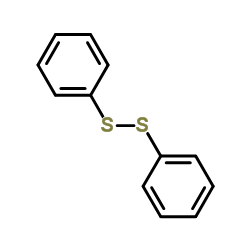Temporary anion states and dissociative electron attachment in diphenyl disulfide.
Alberto Modelli, Derek Jones
Index: J. Phys. Chem. A 110(34) , 10219-24, (2006)
Full Text: HTML
Abstract
The temporary anion states of gas-phase diphenyl disulfide are characterized by means of electron transmission (ET) and dissociative electron attachment (DEA) spectroscopies. The measured energies of vertical electron attachment are compared to the virtual orbital energies of the neutral state molecule supplied by MP2 and B3LYP calculations with the 6-31G basis set. The calculated energies, scaled with empirical equations, reproduce satisfactorily the attachment energies measured in the ET spectrum. The first anion state of diphenyl disulfide is stable, thus escaping detection in ETS. The vertical and adiabatic electron affinities, evaluated with B3LYP/6-31+G calculations as the energy difference between the neutral and anion states, are predicted to be 0.37 and 1.38 eV, respectively. The anion current displayed in the DEA spectrum has a sharp and intense peak at zero energy, essentially due to the C6H5S- negative fragment. In agreement, according to the calculations, the localization properties of the first anion state are strongly S-S antibonding, and the energetic requirement for its dissociation along the S-S bond is fulfilled even at zero energy.
Related Compounds
| Structure | Name/CAS No. | Molecular Formula | Articles |
|---|---|---|---|
 |
Diphenyl disulfide
CAS:882-33-7 |
C12H10S2 |
|
Targeting the fatty acid biosynthesis enzyme, beta-ketoacyl-...
2009-02-26 [J. Med. Chem. 52 , 952-63, (2009)] |
|
The fate of diphenyl sulphide, diphenyl sulphoxide and diphe...
2000-01-01 [Drug Metabol. Drug Interact. 16(3) , 191-206, (2000)] |
|
Functional groups and sulfur K-edge XANES spectra: divalent ...
2010-09-09 [J. Phys. Chem. A 114(35) , 9523-8, (2010)] |
|
Reductive addition of the benzenethiyl radical to alkynes by...
2009-08-06 [Org. Lett. 11(15) , 3298-301, (2009)] |
|
Molecular modeling and enzyme kinetics indicate a novel mech...
1987-01-01 [Adv. Prostaglandin. Thromboxane. Leukot. Res. 17A , 69-74, (1987)] |